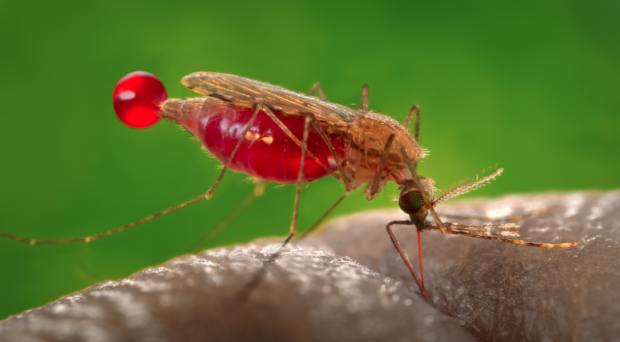
In common with many new discoveries, this story began as an unplanned occurrence that was then investigated further. The colony of Anopheles stephensi mosquitoes at the GSK R&D, Tres Cantos insectary in Spain began to lose its ability to become infected with the human malaria parasite Plasmodium falciparum. Suspecting a microbial infection, the team investigate the microbiota of the mosquito larvae, pupa, and adults, and identified the presence of the bacterium Delftia tsuruhatensis TC1, in the water in the larval rearing trays and in all mosquito stages.
The bacterium was isolated from mosquito midguts and shown to reduce the number of malaria parasites infecting the colony in the Tres Cantos insectary.
Investigating Transmission Blocking Potential
Delftia tsuruhatensis TC1 was sent to be tested on the Anopheles gambiae colony at Johns Hopkins Malaria Research Institute. Mosquitoes were fed a sugar solution alone, one containing this bacterium or another bacteruim (Pantoea agglomerans). This was followed by a bloodmeal infected with Plasmodium falciparum or the rodent malaria, P. berghei.
- P. falciparum oocyst formation was greatly inhibited in Delftia infected mosquitoes compared with the controls; an effect that lasted at least 16 days. P. berghei oocyst formation was also inhibited, and transmission to mice was reduced from 33% to 100%.
Ideally, a bacterium that could be used to inhibit malaria transmission should have no fitness costs to the mosquito, and can be transmitted vertically to the next generation. Investigations indicated that mosquito longevity, fecundity and fertility were not affected by infection with Delftia. Adding the bacterium to the water in which larvae were reared only affected larvae and pupae when in high doses.
By inserting a fluorescent gene into Delftia to track it, the researchers found that the bacterium persisted through the pupal stage to infect adult midguts, but, unfortunately, it did not infect mosquito ovaries and was not transmitted vertically to the next generation. Nor did horizontal transmission occur during mating. This finding thus precluded the potential for the long-term introduction of this malaria-inhibiting bacterium into mosquito populations.
The mechanism of transmission blocking
Feeding a cell-free supernatant of bacterial cultures to mosquitoes inhibited oocyst development and passage through a 3kDd filter, while heat treatment and treatment with proteinase K established that the bacteria produced a small, heat stable inhibitor that was not proteinaceous.
Further experiments showed that the inhibitor worked very early in development of the parasite, when within the midgut lumen, in a dose dependent manner. Male gametogenesis (exflagellation) was not affected, but ookinete formation was.
Identification of the inhibitor molecule
By testing fractions of the cell-free supernatant the researchers found two potent fractions, and a variety of spectroscopic techniques identified the major component of these fractions to be harmane (1-methyl-β-carboline). A dose response curve for harmane was established, with 90% reduction in oocyst formation at 150 nM.
Harmane
Not only did harmane inhibit oocyst development when imbibed by mosquitoes, it also acted as a contact poison. The small size of the molecule allowed it to penetrate the insect’s cuticle, and it was equally as effective when administered this way, or when taken orally. However, unlike the effect of the intact bacterium, harmane lost its inhibition activity a couple of days after administration.
Harmane appears to specifically affect the parasite’s sexual development, as it had no effect upon the asexual blood stages of two strains of P. falciparum.
A potential control agent
To assess Delftia potential, the group turned to modelling. Their scenario involved infecting mosquitoes in a seasonally high-transmission area via sugar baits used alongside insecticide impregnated bednets (ITNs). The model predicted a 15% reduction in cases of malaria over a 3-year period. This suggested the bacterium might be a useful tool when used in conjunction with other control measures. It could be particularly useful in areas where a change in mosquito behaviour towards biting outdoors is rendering bednets less useful.
Results from initial field studies, conducted in Burkina Faso, were very encouraging. Researchers used a MosquitoSphere facility. This is an enclosed structure that simulates environmental conditions, in which a lab colony of mosquitoes can develop freely. Mosquitoes were successfully infected as adults using bacteria-baited cotton balls, or as larvae developing in water containing Delftia. By feeding these mosquitoes on blood from local malaria patients the researchers demonstrated a 74% reduction in malaria development. Finally, the researchers demonstrated that wild mosquitoes (caught in a local village) could also be infected, via cotton balls soaked in a suspension of Delftia, as efficiently as the lab reared ones.
In an extensive discussion, the authors of this paper summarise the advantageous aspects of the biology of Delftia tsuruhatensis TC1 that promote its development as a malaria control tool. For instance, its inhibition of the development of mosquito stages of both a human and a rodent malaria suggests it may be effective against other human-malaria species and, likewise, its activity in two species of malaria vectors means it may infect others.
They regard the lack of transovarial transmission as a positive trait, as infection being limited to a single generation will curtail any environmental spread to non-target species.
With respect to using harmane directly as an anti-malaria compound, the authors point out that regulatory issues would be minimal as it occurs naturally in human tissues, plant extracts and a variety of foods.
Its short half-life in mosquitoes means it would only be effective if contact was made immediately before or after feeding on infected blood. However, as female mosquitoes rest immediately after feeding, it could be used to coat likely resting places and the development of a slow-release formulation would enhance its potential.

Comments